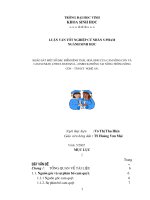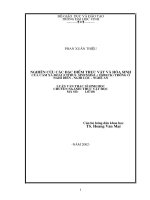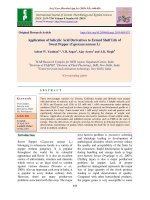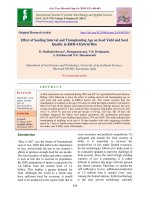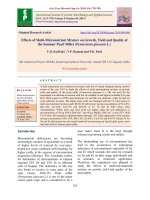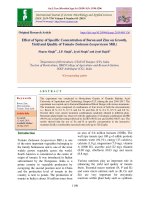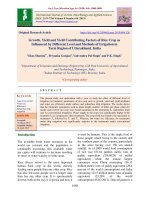Foliar feeding of micronutrients: An essential tool to improve growth, yield and fruit quality of sweet orange (Citrus sinensis (L.) Osbeck) cv. mosambi under non-traditional citrus growing
Bạn đang xem bản rút gọn của tài liệu. Xem và tải ngay bản đầy đủ của tài liệu tại đây (264.8 KB, 11 trang )
Int.J.Curr.Microbiol.App.Sci (2020) 9(3): 473-483
International Journal of Current Microbiology and Applied Sciences
ISSN: 2319-7706 Volume 9 Number 3 (2020)
Journal homepage:
Original Research Article
/>
Foliar Feeding of Micronutrients: An Essential Tool to Improve Growth,
Yield and Fruit Quality of Sweet Orange (Citrus sinensis (L.) Osbeck) cv.
Mosambi under Non-traditional Citrus Growing Track
Kumari Nandita, Manoj Kundu, Ruby Rani, Farhana Khatoon* and Deepak Kumar
1
Department of Horticulture (Fruit & Fruit Technology), BAU, Sabour,
Bhagalpur, Bihar, India- 813210, India
*Corresponding author
ABSTRACT
Keywords
Calcareous soil,
foliar feeding, fruit
quality,granulation,
micronutrients,
mosambi, nonconventional area.
Article Info
Accepted:
05 February 2020
Available Online:
10 March 2020
Calcareous and alkaline nature of the soil under non-traditional citrus growing track is the
major drawback for low yield and poor fruit quality of mosambi with increased granulation
problem. Generally, these type of soil hinders the smooth up take of micronutrient to the
plants from soil. Hence, the present investigation was design to evaluate the impact of
foliar feeding of micronutrients on growth, yield and fruit quality of sweet orange (Citrus
sinensis (L.) Osbeck) cv. Mosambi. The observations revealed that treatment combination
of Zn @ 0.5%+ Fe @ 0.2% + B @ 0.3% + Cu @ 0.1% followed by B @ 0.3% + Fe
@0.2% and Zn @ 0.5% + B @ 0.3% were most effective for improving vegetative growth
of sweet orange cv. Mosambi in terms of plant height and trunk girth increment, canopy
volume and growth of current season shoot. The commencement of reproductive growth in
terms of 50% bloom after bud break as well as full bloom after bud break with maximum
flowering and fruit setting was also obtained in in Zn @ 0.5% + Fe @ 0.2% + B @ 0.3% +
Cu @ 0.1% spray followed by B @ 0.3% + Fe @0.2% and Zn @ 0.5% + B @ 0.3%. the
yield was calculated maximum in the treatment consist of Zn @ 0.5% + Fe @ 0.2% + B
@ 0.3% + Cu @ 0.1% (8.06 t acre-1). Further, fruit quality attributes in terms of sugar:acid
ratio, sucrose content, carotenoid content and edible: non-edible ratio was recorded
maximum with Zn @ 0.5% + Fe @ 0.2% + B @ 0.3% + Cu @ 0.1% spray (41.88, 4.44%,
0.59 mg 100 g-1).Therefore, three foliar spay of Zn @ 0.5%+ Fe @ 0.2% + B @ 0.3% +
Cu @ 0.1%from May- July may be recommended to get maximum yield of better quality
mosambi fruit under non-conventional citrus growing track having calcareous and alkaline
nature of soil.
economically
important
fruits
grown
worldwide. Further, itplays animportant
nutritional role in our daily food
requirements, being a rich source of Vitamin
C. (Gregory 1993) Apart from this, citrus
fruit contain phenolics compounds, protein,
minerals, vitamins, pigments, volatile
Introduction
The citrus, belongs to family Rutaceae,
constitutes a major group of fruits; composed
of citron, citrange, orange, mandarin, lime,
lemon, lemonime, grapefruit, pummelo,
tangelo, etc. It is one of the most
473
Int.J.Curr.Microbiol.App.Sci (2020) 9(3): 473-483
compounds (present in the essential oil),
lipids, sugars, acids and fibre (Bampidis and
Robinson
2006).
These
components
ultimately increase the nutritional as well as
antioxidant properties of the fruit (Bermejo et
al., 2011) and make them an important
produce for human health (Barros et al.,
2012). Now, with increasing awareness about
the
nutritional
security
and
faster
development of processing industries
throughout the globe, the demand of this crop
has increased tremendously.
2009; Khurshid et al., 2008; Zekri and Obreza
2003).These are involved in the synthesis of
many compounds essential for plant growth
and development. Further, by acting as the
activators for various other enzymes,
micronutrients can tremendously boost the
crop yield and post-harvest life of
horticultural produce (Raja 2009) while their
deficiency can turn healthy orchard
unproductive with poor yield and quality.
Hence, micronutrient management is one of
the key technologies to enhance the
production of quality fruits not only in citrus
but in all the perennial fruit crops
(Sikarwarand Tomar2018; Abhijith et al.,
2018; Guvvali et al., 2017).Few experiments
have been conducted earlier on the
application of micronutrient on different fruit
crops and shown significant improvement in
yield and quality (Kumar and Verma 2004)
through improved growth, better flowering
and higher fruit set (Ram and Bose 2000).
Keeping this growing demand of citrus fruits
in view, the area of the crop in India has also
increased at a faster rate even in nontraditional citrus growing area during the last
2-3 decades, resulting a sharp increase in total
area of citrus in the country from 0.39 million
hectares in 1991-92 to 1.03 million hectares
in 2017-18(Anonymous 2018).
Despite of faster area expansion, the
productions as well as fruit quality of the crop
particularly under non-traditional area are not
improved at satisfactory level. One of the
main reasons behind this low yield and poor
fruit quality of mosambi under non-traditional
citrus growing track is the calcareous and
alkaline nature of the soil which hinders the
smooth up take of micronutrient to the plants
from soil (Zekri and Obreza 2003) resulting
acute deficiency of micronutrient to the
plants.
Therefore, application of micro-nutrients
along with primary and secondary nutrients
becomes very pertinent to avert the emerging
nutrient deficiencies and to evolve sustainable
production technology with increased
productivity of citrus crops particularly under
non-conventional citrus growing track.
However, soil application of micronutrients is
not very effective to recover these
deficiencies in calcareous and alkaline soils.
Hence, application of these micronutrient
through any other alternate but effective
methods could be one of the productive
options.
Further, the competitions for water and
nutrient; application of major nutrients
through straight or mixed fertilizers leads to
the depletion of micronutrients resulting less
availability of the same to the plant.However,
micronutrients are required in small amount
but play a great role in plant metabolism
(Katyal 2004; Kazi et al., 2012). Among
different micronutrients, zinc, iron, boron and
copper plays the vital role in plant metabolism
of citrus (Sohrab et al., 2013; Stenico et al.,
Foliar feeding of micronutrients, particularly
in perennial crops has gained considerable
attention in recent time due to its highly
recognized effect on yield and quality of crop
(Bhanukar et al., 2018; Singh et al., 2017).
Foliar feeding gives quick response as the
474
Int.J.Curr.Microbiol.App.Sci (2020) 9(3): 473-483
application is directly on leaves. In addition,
foliar feeding avoids soil interactions and can
be used in combination with existing spray
programs.
Vegetative, physiologicaland reproductive
growth of the plants was observed under field
condition. After harvesting, yield was
calculated and biochemicalanalyses of fruit
were carried out.
Hence, the present investigation was carried
out to investigate the effect of foliar feeding
of micronutrients on granulation and fruit
quality of sweet orange (Citrus sinensis(L.)
Osbeck) cv. Mosambi under non-conventional
area of the crop.
Vegetative and physiological growth of the
plant
To measure the increment in plant height,
trunk girth and canopy volume as influenced
by the foliar spray of micronutrients, the
height of the plant, trunk girth and canopy
volume was measured before foliar
application of micronutrients and again after
harvesting of fruits from the entire
experimental orchard. Thereafter, net
increment was calculated by subtracting the
value of initial observation from the final one
after harvesting.
Materials and Methods
Ten years old sweet orange (Citrus sinensis
(L.) Osbeck) cv. Mosambi was selected as the
experimental plant. All the plants were in
uniform growth and free from any injuries
and pest and disease infestation.
Treatment details
However, growth of current season shoot was
measured after all the foliar application.
Further, chlorophyll content (chlorophyll a,
and b) of the leaves was analysed at
vegetative stage and again at fruiting stage
following the method of Barnes et al., (1992)
and the ratio of chlorophyll a: b was
calculated thereafter.
The trail was continued with the following
treatment combinations- T1: Control (treated
with distilled water); T2:Zn @ 0.5%; T3:Cu @
0.1%; T4:B @ 0.3%; T5:Cu @ 0.1%+ Fe @
0.2%; T6:B @ 0.3% + Fe @0.2%; T7:Zn @
0.5% + B @ 0.3%; T8:Cu @ 0.1% + B @
0.3%; T9:Zn @ 0.5%+ (Fe @ 0.2% + B @
0.3% + Cu @ 0.1%). Working solutions were
sprayed though foot sprayer to the entire
canopy of the selected mosambi plants during
the morning hours.
Period of 50% flowering after bud break as
well as full bloom after bud break was
measured by counting the days taken to come
50% flowering and full bloom after bud break
respectively.
Three foliar spray at one month interval was
done on each experimental plant starting from
the month of May. Among the selected
micronutrient, application of zinc solution
was done fifteen days before the application
of other micronutrients at each interval to
avoid any antagonistic effect among these
micronutrients. Zn-EDTA (chelated), CuEDTA (chelated), Fe-EDTA (chelated)and
Solubor were used as the source of Zn, Cu, Fe
and B respectively.
Reproductive growth, yield and fruit
quality attributes
Total numbers of flowers per shoot was
recorded by counting the flowers on each
shoot at full bloom. Thereafter, total number
of fruit setting was also counted similarly.
Further, Total number of harvestable fruits
retained on each experimental plant was
counted manually and fruit yield per plant
475
Int.J.Curr.Microbiol.App.Sci (2020) 9(3): 473-483
was measured by weighing all the harvested
fruits from individual plant using digital
weighing balance. Thereafter, yield per acre
area was calculated by using following
formula-
observations were analysed by using
OPSTAT software (OPSTAT, CSS HAU,
Hisar India).
Results and Discussion
Vegetative and physiological growth of the
plant
A perusal of data pertaining to plant height
increment differed significantly due to the
effect of various micronutrient treatments
(Table 1). As compared to control, plant
height has increased in each and every
treatment and it was observed maximum in
the treatment consist of foliar feeding of Zn
@0.5% + Fe @0.2% + B @0.3% + Cu
@0.1% (T9) (99.71% higher than the control).
Similarly, increment of trunk girth was
measured maximum in the treatment consist
of foliar feeding of Zn @0.5% + Fe @0.2% +
B @0.3% + Cu @0.1% (T9) flowed by B @
0.3% + Fe @ 0.2% (T6) (4.84 cm and 4.63
cm, respectively) with minimum in control
(4.05 cm) (Table 1).
Peel of individual mosambi fruit was
separated manually and juice content was
extracted. Thereafter edible: non-edible ratio
was measured. Sugar:acid ratio was
determined by dividing the total sugar content
in the juice with titratable acidity for ten
individual fruits under each replication and
average value was calculated thereafter Sugar
content in the ripe fruit was estimated by
Lane and Eynone (1923) method.
Total carotenoids content of fruit juice was
determined by the method of Roy (1973) with
some modifications. In which 5 g of juicy
vessiclas was crushed in acetone till the tissue
became colourless. Then the extracted
solution was poured into a separating funnel.
To it, petroleum ether and small amount of
sodium sulphate solution was added and
shaken rigorously.
Among all the treatments, increment in
canopy volume was recorded maximum in the
plant treated with Zn @0.5% + Fe @0.2% +
B @0.3% + Cu @0.1% (T9) followed by B @
0.3% + Fe @ 0.2% (T6) (12.37 cm3 and 12.08
cm3, respectively) with minimum in control
(9.98 cm3). On the other hand, growth of
current season shoot was also varied
significantly over control in all the
micronutrient treatment with maximum in Zn
@0.5% + Fe @0.2% + B @0.3% + Cu
@0.1% (T9) with at par result in B @ 0.3% +
Fe @ 0.2% (T6)(9.57 cm and 9.50 cm,
respectively).
Then the separating funnel was kept
undisturbed to separate the carotenoids from
acetone to petroleum ether layer. After that,
coloured solution was separated in a 50 ml
volumetric flask and the volume was adjusted
with petroleum ether. Finally, the sample
absorbance was measured at 452 nm in a
(HALO DB-20S UV-VIS double beam)
spectrophotometer, using petroleum ether as
blank. The results was expressed as mg/100 g
fresh weight.
On the other hand, ratio of chlorophyll A:B at
vegetative stage was recorded maximum in B
@ 0.3% + Fe @ 0.2% (T6)with statistically at
par result inZn @0.5% + Fe @0.2% + B
@0.3% + Cu @0.1% (T9) (3.10 and 3.06,
Statistical analysis
The experiment was laid out in randomized
block design with three replications. The
476
Int.J.Curr.Microbiol.App.Sci (2020) 9(3): 473-483
respectively) while minimum in control (1.94)
(Table 2). However, at fruiting stage, it was
increased drastically in control and reach to
maximum level as compared to other
treatment (2.49) with minimum in Cu @ 0.1%
+ B @ 0.3% (T8).
treatment with statistically at par result in Zn
@0.5% + B @0.3% (T7) and B @ 0.3% + Fe
@ 0.2% (T6) treatment (79.91%, 74.33% and
71.79% higher than the control) (Table 3).
Apart from these, fruit yield was also
increased significantly over control in the
plants sprayed with Cu @ 0.1% + B @ 0.3%
(T8), Cu @ 0.1% + Fe @ 0.2% (T5), B alone
@ 0.3% (T4) and Zn alone @ 0.5% (T2)
treatment (55.24%, 40.14%, 39.42% and,
18.08%higher than control). However, it was
computed minimum in control (4.48
tonnesacre-1) with par value in Cu spray alone
@ 0.1% (T3) (4.52tonnesacre-1).
Reproductive growth, yield and fruit
quality attributes
The perusal of data regarding period of 50%
flowering as well as full bloom after bud
break indicates a significant variation among
the treatments as influenced by micronutrient
application (Table 2). The commencement of
50% flowering as well as full bloom after bud
break was earliest in the treatment consist of
Zn @0.5% + Fe @0.2% + B @0.3% + Cu
@0.1% (T9) (6.0 day s and 15.33 days,
respectively after bud break) with at par result
in B @ 0.3% + Fe @ 0.2% (T6) (6.33 days
and 15.67 days, respectively).
Perusal of data pertaining to edible to nonedible ratio of ripped mosambi fruits(table 3)
indicates that the control had minimum
ratio(0.640) while it was increased
significantly in all the micronutrient treatment
with maximum in Zn @0.5% + Fe @0.2% +
B @0.3% + Cu @0.1% (T9)which was
statistically at par with combined spray of Zn
@0.5% + B @0.3% (T7) (0.840).
Apart from these two treatment it was also
earlier in all the treatments as compared to
control. However the plants under control
took maximum time to come into 50%
flowering as well as in full blooming
condition (11.00 days and 20.00 days after
bud break, respectively).
Among biochemical attributes, sucrose%,
Sugar: Acid ratio and carotenoid content in
ripped mosambi fruits was recorded
maximum in the treatment consist of foliar
spray of Zn @0.5% + Fe @0.2% + B @0.3%
+ Cu @0.1% (T9) (4.44%, 41.88 and 0.59 mg
100 g-1, respectively) with at par result in Zn
@0.5% + B @0.3% (T7). However, all these
biochemical attributes of ripped mosambi
fruit also enhanced significantly in all the
micronutrient treatments as compared to
control (3.31%, 17.45 and 0.37 mg 100 g-1,
respectively) (Table 3).
On the other hand, total number of flower per
shoot as well as total number of fruit setting
per shoot was estimated maximum (63.00 and
27.67, respectively) in the plant treated with
Zn @0.5% + Fe @0.2% + B @0.3% + Cu
@0.1% (T9) followed by B @ 0.3% + Fe @
0.2% (T6) (Table 3). Apart from these fruit
setting was also increased significantly over
control in all the treatment combinations.
Similar pattern was also observed for fruit
yield.
Physiological growth of the plant
Generally foliar application of micronutrients
increased all the photosynthetic compounds
significantly within the plant system resulting
improved vegetative and physiological
Fruit yield was recorded maximum in
combined application of Zn @0.5% + Fe
@0.2% + B @0.3% + Cu @0.1% (T9)
477
Int.J.Curr.Microbiol.App.Sci (2020) 9(3): 473-483
growth of the plant with reduced leaf drop. Zn
helps to increase the rate of cell division and
elongation (Cakmak 2008) and also
accelerates
the
rate
of
metabolites
translocation (Hatwar et al., 2003). Further,
Zn also increases the rate of photosynthesis in
the plant system by increasing the activity of
carbonic anhydrase (Qiao et al., 2009).
spray of boron increases the level of sugar in
the stigma resulting improved pollen
germination. Further, it promotes the pollen
tube growth which ultimately helps in early
flowering and fruit setting (Singh et al.,
2003).
In addition, it regulates carbohydrate
metabolism in the plants and accelerate the
carbohydrate supply to the reproductive buds
resulting improved flower and fruit setting
with decreased flower and fruit abscission
(Smit and Combrink 2005). However, foliar
feeding of Zn enhanced the photosynthates
translocation at faster rate to the developing
fruits and decreased the flower and fruit
abscission by increasing IAA synthesis
(Shnain et al., 2014; Singh and Tawari 2013;
Graham et al., 2000; Ruby et al., 2001).
Boron indirectly increased the rate of
photosynthesis by involving in the
carbohydrate metabolism. On the other hand,
Fe helps in the formation of chlorophyll and
activation of several enzymes including those
involved in the oxidation or reduction
processes of photosynthesis and respiration
and being a good synthesizer of carbohydrate
in the plant system, Fe acts as a strong sink
(Sohrab et al., 2013) resulting improved
physiological growth before the start of
reproductive phase.
Hence, the combined application of Zn, Fe, B
and Cu enhanced the photosynthetic activities
significantly in the plant system resulting
improved carbohydrate translocation from
source to sink. Therefore, treatment T9 had
maximum yield followed by treatment T7.
However, Cu influenced the metabolic
activity in the plant system by involving in
different metabolic pathways (including ATP
synthesis) as cofactor for various enzymes
(Sharma and Agrawal 2005). Further, Cu
helps in the carbohydrate and nitrogen
metabolism in citrus (Stenico et al., 2009)
resulting improved physiological growthin
sweet orange cv. Mosambi.
These results confirm the earlier findings of
Singh and Tiwari (2013), Ashraf et al., (2012)
and Tariq et al., (2007) who reported that the
increased production of photosynthatesunder
these treatmentswas utilized by the
developing fruits resulting increased fruit
yield.
Hence, combined application of all these four
micronutrients (Fe, Zn, Cu and B) ultimately
enhanced the physiological activities in the
plant system significantly resulting improved
vegetative growth in term of increment of
plant height, trunk girth, canopy volume and
current season shoot.
Fruit quality in terms of edible to non-edible
ratio, sucrose content, sugar:acid ratio and
carotenoid content in the ripped mosambi
fruit has increased significantly in all the
micronutrient treated plants as compared to
control. However, all the fruit quality
attributes were estimated maximum in
combined application of Zn @0.5% + Fe
@0.2% + B @0.3% + Cu @0.1% (T9)
followed by Zn @0.5% + B @0.3% (T7).
Reproductive growth, yield and fruit
quality attributes
Zn and B plays significant role on
reproductive growth of the plants. Foliar
478
Int.J.Curr.Microbiol.App.Sci (2020) 9(3): 473-483
Table.1 Effect of foliar feeding of micronutrients on vegetative growthof sweet orange
(Citrus sinensis (L.) Osbeck) cv. Mosambi
Treatment
Plant height
increment
(cm)
Canopy
Volume (cm3)
Growth of current
season shoot
(cm)
17.57±0.02
21.07±0.50
21.28±0.57
25.12±0.69
23.82±0.94
32.77±1.13
30.03±0.97
28.15±0.79
35.09±0.45
Trunk
girth
increment
(cm)
4.05±0.02
4.14±0.02
4.17±0.02
4.22±0.05
4.20±0.03
4.63±0.06
4.44±0.04
4.35±0.04
4.84±0.10
T1- Control
T2- Zn @ 0.5%
T3 -Cu @ 0.1%
T4- B @ 0.3%
T5- Cu @ 0.1%+ Fe @ 0.2%
T6- B @ 0.3% + Fe @0.2%
T7- Zn @ 0.5% + B @ 0.3%
T8-Cu @ 0.1% + B @ 0.3%
T9- Zn @ 0.5%+ (Fe @ 0.2%
+ B @ 0.3% + Cu @ 0.1%)
9.98±0.05
10.46±0.04
10.72±0.07
11.34±0.05
11.15±0.06
12.08±0.03
11.93±0.03
11.66±0.05
12.37±0.08
6.95±0.04
7.65±0.06
8.46±0.05
8.92±0.03
8.74±0.10
9.50±0.03
9.37±0.07
9.16±0.05
9.57±0.06
CD (≤0.05)
CV (%)
2.59
5.68
0.13
1.65
0.17
0.85
0.18
1.17
Value indicates mean of three replicates. Different letters in the same column indicate significant differences at P ≤
0.05 (Duncan’s Multiple Range Test).
Table.2 Effect of foliar feeding of micronutrients on physiological and reproductive growth of
sweet orange (Citrus sinensis (L.) Osbeck) cv. Mosambi
Treatment
T1- Control
T2- Zn @ 0.5%
T3 -Cu @ 0.1%
T4- B @ 0.3%
T5- Cu @ 0.1%+ Fe @ 0.2%
T6- B @ 0.3% + Fe @0.2%
T7- Zn @ 0.5% + B @ 0.3%
T8-Cu @ 0.1% + B @ 0.3%
T9- Zn @ 0.5%+ (Fe @ 0.2%
+ B @ 0.3% + Cu @ 0.1%)
CD (≤0.05)
CV (%)
Chlorophyll A:B ratio in
leaf
Vegetative
Fruiting
stage
stage
1.94±0.06
2.43±0.21
2.47±0.20
2.94±0.20
2.73±0.22
2.69±0.15
3.10±0.19
2.69±0.09
3.06±0.18
2.49±0.11
1.66±0.15
1.95±0.04
1.46±0.07
1.26±0.09
1.40±0.05
1.64±0.06
1.25±0.06
1.41±0.03
Duration to
50% flowering
after bud
break
(days)
11.00±0.58
9.67±0.67
9.00±0.58
8.00±0.58
8.33±0.33
6.33±0.33
6.67±0.67
7.33±0.33
6.00±0.58
0.58
11.93
0.26
9.14
1.23
8.76
Duration to
full bloom
after bud
break
(days)
20.00±0.58
19.33±0.33
19.33±0.82
17.67±0.33
18.00±0.25
15.67±0.33
16.33±0.33
17.67±0.67
15.33±0.33
1.38
4.45
Value indicates mean of three replicates. Different letters in the same column indicate significant differences at P ≤
0.05 (Duncan’s Multiple Range Test).
479
Int.J.Curr.Microbiol.App.Sci (2020) 9(3): 473-483
Table.3 Effect of foliar feeding of micronutrients on yield and fruit quality of sweet orange (Citrus sinensis (L.)Osbeck) cv. Mosambi
Treatment
Total number Total number
of flowers
of fruit
shoot-1
setting shoot-1
Yield
(t acre-1)
Fruit quality attributes
Edible: nonedible ratio
T1- Control
T2- Zn @ 0.5%
41.33±0.88
46.00±0.58
15.67±0.33
17.33±0.33
4.48±0.07
5.29±0.04
0.640±0.017
0.730±0.015
Sucrose
content
(%)
3.31±0.02
4.03±0.11
Sugar:
Acid ratio
17.45±0.23
22.53±0.69
Carotenoid
content
(mg 100 g-1 FW)
0.37±0.003
0.40±0.004
T3 -Cu @ 0.1%
44.67±1.76
17.33±0.33
4.52±0.05
0.743±0.032
4.04±0.07
20.98±1.27
0.43±0.003
T4- B @ 0.3%
48.33±0.88
19.67±0.33
6.25±0.10
0.743±0.026
3.70±0.18
25.17±1.28
0.49±0.002
T5- Cu @ 0.1%+ Fe @
0.2%
T6- B @ 0.3% + Fe @0.2%
48.00±0.58
19.33±0.67
6.28±1.04
0.743±0.007
3.65±0.20
25.64±0.82
0.48±0.004
59.00±1.16
25.00±0.58
7.70±0.28
0.770±0.017
4.20±0.12
36.88±1.40
0.55±0.002
T7- Zn @ 0.5% + B @
0.3%
T8-Cu @ 0.1% + B @ 0.3%
57.33±1.20
22.67±0.88
7.81±0.09
0.840±0.015
4.53±0.15
39.96±1.35
0.54±0.004
52.67±1.20
21.00±0.58
6.95±0.13
0.797±0.027
3.51±0.14
31.72±1.05
0.52±0.006
T9- Zn @ 0.5%+ (Fe @
0.2% + B @ 0.3% + Cu @
0.1%)
CD (≤0.05)
CV (%)
63.00±1.53
27.67±1.45
8.06±0.12
0.853±0.049
4.44±0.08
41.88±1.40
0.59±0.006
3.36
3.76
2.20
6.12
0.39
3.53
0.079
5.92
0.40
5.86
3.54
6.96
0.01
1.20
Value indicates mean of three replicates. Different letters in the same column indicate significant differences at P ≤ 0.05 (Duncan’s Multiple Range Test).
480
Int.J.Curr.Microbiol.App.Sci (2020) 9(3): 473-483
In both the treatment, the improvement of
fruit quality is mainly associated with the role
of Zn and B. Zn play important role for the
synthesis of different enzymes during fruit
developmental stages which accelerate the
formation of higher amount of protein, acids
and sugars (Srivastava and Gupta 1996)
resulting increased TSS: acid ratio.
Cu @ 0.1%) during the month of May, June
and July may be recommended for getting
maximum profit from mosambi orchard
having calcareous and alkalinenature of soil.
References
Abhijith, Y.C., Dinakara, J.A.,Kishor,H.
andSindhu, C. 2018. Effect of
Micronutrients on Yield and Quality of
Aonla (EmblicaofficinalisGaertn.) cv.
NA-7. International Journal of Current
Microbiology and Applied Sciences.7
(03): 140-145.
Alloway, B.J. 2008. Zinc in soils and crop
nutrition.
International
Zinc
Association,
Brussels,
Belgium.
American Journal of Botany.27: 939951.
Anonymous 2018. Horticultural statistics at a
glance. Horticulture Statistics Division,
Department of Agriculture, Cooperation
and Farmers’ Welfare, Ministry of
Agriculture and Farmers’ Welfare,
Government of India. India Offset
Press, New Delhi.
Ashraf, M.Y., Yaqub, M.,Akhtar, J.,Khan,
M.A. and Ebert, G. 2012. Control of
excessive fruit drop and improvement in
yield and juice quality of kinnow
(Citrus deliciosa × Citrus nobilis)
through nutrient management. Pakistan
Journal of Botany.44: 259-265.
Babu, K.D. and Yadav, D.S. 2005. Foliar
spray of micronutrients for yield and
quality improvement in Khasi mandarin
(Citrus reticulate Blanco.). Indian
Horticulture Journal.62: 280-281.
Bampidis, V.A. and Robinson,P.H. 2006.
Citrus by-products as ruminant feeds: A
review. Animal Feed Science and
Technology. 128: 175–217.
Barnes, J.D., Balaguer, L., Manrique, E.,
Elvira, S. and Davison, A.W. 1992. A
reappraisal of the use of DMSO for the
extraction and determination of
Further, Zn specifically accelerates the
activity of aldolase enzyme which in turn
helps in more accumulation of sugar in the
fruits. On the other hand, boron helps to
increase sugar translocation from source to
sink by forming B complex with the sugar
element (furanosecis-diol structure). In
addition, Fe helps in the synthesis
carbohydrate in the plant system and act as a
strong sink (Sohrab et al., 2013) which
ultimately helps to enhance the sugar content
and TSS in ripped mosambi fruits (Ram and
Bose, 2000) while copper has positive impact
on improving fruit quality particularly TSS
and sugar content in ripe fruits (Khurshid et
al., 2008).
Hence the combined application of Zn, Fe, Cu
and B together as well as Zn and B together
ultimately improved the overall fruit quality
attributes significantly as compared to other
treatment which confirm the earlier findings
of Alloway (2008); Tariq et al., (2007) and
Babu and Yadav (2005).
In addition, due to maximum translocation of
food reserves from source to sink under these
two treatments (T9 and T7), the rag percent
was recorded minimum in T9 and
T7treatments. The result of the present
investigation showed that the treatment
combination of Zn @ 0.5%+ (Fe @ 0.2% + B
@ 0.3% + Cu @ 0.1%) was most effective for
improving growth, yield and quality attributes
of sweet orange (Citrus sinensis (L.) Osbeck)
cv. Mosambi. Hence, three foliar application
of Zn @ 0.5%+ (Fe @ 0.2% + B @ 0.3% +
481
Int.J.Curr.Microbiol.App.Sci (2020) 9(3): 473-483
chlorophylls a and b in lichens and
higher plants. Environmental and
Experimental Botany. 32: 85-100.
Barros,
H.R.,
Ferreira,
T.A.
and
Genovese,M.I.
2012.
Antioxidant
capacity and mineral content of pulp
and peel from commercial cultivars of
citrus from Brazil. Food Chemistry. 134
(4): 1892-1898.
Bermejo, A., Pardo, J. and Cano,A. 2011.
Influence of gamma irradiation on
seedless citrus production: pollen
germination and fruit quality. Food and
nutrition science. 2: 169-180.
Bhanukar, M., Rana, G.S.,Sehrawat, S.K. and
Preeti. 2018. Effect of exogenous
application of micronutrients on growth
and yield of sweet orange cv. Blood
Red. Journal of Pharmacognosy and
Phytochemistry. 7(2): 610-612.
Cakmak, I. 2008. Enrichment of cereal grains
with zinc:Agronomic or genetic
biofortification. Plant Soil.302: 1-17.
Graham, R.D., Welch, R.M. and Bouis, H.E.
2000.
Addressing
micronutrient
nutrition through enhancing the
nutritional quality of staple foods.
Advances in Agronomy.70: 77-161.
Gregory,
J.F.
1993.
Ascorbic
acid
bioavailability
in
foods
and
supplements. Nutrition Review. 51:
301-303.
Guvvali, T., Sampath, P.M., Shirol,
A.M.,Rao, B.B., Nirmala,P. and
Sumangala, K. 2017. Influence of
micronutrients on growth, yield and
economy of sapota cv. kalipatti under
HDP system. International Journal of
Agricultural Science and Research.
7(3): 401-408.
Hatwar, G.P., Gondane,S.V. Urkude, S.M.
and Gahukar, O.V. 2003. Effect
ofmicronutrients on growth and yield of
chilli. Journal of Soils and Crops. 13:
1239-1254.
Katyal, J. C. 2004. Role of micronutrients in
ensuring
optimum
use
of
macronutrients.
IFA
International
symposium on micronutrients, New
Delhi, India, 3-17 pp.
Kazi, S.S., Ismail, S. and Joshi, K.G. 2012.
Effect of multi-micronutrient on yield
and quality attributes of sweet orange.
African
Journal
of
Agricultural
Research. 7(29): 4118-4123.
Khurshid, F., Khattak, R.A. and Sarwar, S.
2008. Effect of foliar (Zn, Fe, Cu and
Mn) in citrus production. Science,
Technology and Development. 27: 3442.
Kumar, S. and Verma, D.K. 2004. Effect of
micro-nutrients and NAA on yield and
quality of litchi cv. Dehradun.
Proceedings of International Seminar on
Recent Trend in Hi-tech Horticulture
and Post Harvest Technology 193 pp.
Lane,
J.H.
and
Eynone,L.
1923.
Determination of reducing sugars by
means of Fehling solution with
methylene blue indicator as an internal
indicator. Journal of Indian Chemical
Society. 42: 32-36.
Qiao, X., He, Y.,Wang, Z.,Li, X.,
Zhang,K.and Zeng,H. 2009. Effect of
foliar spray of β carbonic anhydrase
expression and enzyme activity in rice
(OryzasativaL.)
leaves.
ActaPhysiologiaPlantarum.36: 263-272.
Raja,
E.M.
2009.
Importance
of
micronutrients
in
the
changing
horticultural scenario. Journal of
Horticultural Science.4(1): 1-27.
Ram, R.A. and BoseT.K. 2000. Effect of
foliar application of mangnesium and
micronutrients on growth, yield and
fruit
quality of mandarin orange.
Indian Journal of Horticulture57(3):
215-220.
Roy, S.K. (1973). Simple and rapid methods
for the estimation of total carotenoids
pigments in mango. Journal of Food
Science and Technology. 10(1): 45–46.
482
Int.J.Curr.Microbiol.App.Sci (2020) 9(3): 473-483
Ruby, R., Brahmachari, V.S. and Rani,R.
2001. Effect of foliar application of
calcium, zinc and boron on cracking
and physicochemical composition of
litchi. Orissa Journal of Horticulture29:
50-54.
Sharma, R.J. and Agrawal,M. 2005.
Biological effects of heavy metals: An
overview. Journal of Experimental
Botany.26: 301-313.
Shnain, R.S., Prasad,V.M. and Saravanan,S.
2014. Effect of zinc and boron on
growth, yield and quality of tomato
(Lycopersicon esculentum Mill) cv.
HeemSohna under protected cultivation.
European Academic Research.3: 45724597.
Sikarwar, P.S. and Tomar, K.S. 2018.
Nutrient management study in sweet
orange (Citrus sinensis L) cv.
Mosambi.Journal of Pharmacognosy
and Phytochemistry. 7(2): 2217-2219.
Singh, H.M. and Tiwari, J.K. 2013. Impact of
micronutrient spray on growth, yield
and quality of tomato (Lycopersicon
esculentum Mill). Hort Flora Research
Spectrum.2(1): 87-89.
Singh, S., Parekh, N.S.,Patel, H.R.,Kore,P.N.
and Vasara, R.P. 2017. Effect of Soil
and Foliar Application of Multi
Micronutrients on Fruit Yield and
Physical Parameters of Fruit of Mango
(Mangifera indica L.) var. Amrapali.
International Journal of Current
Microbiology and Applied Sciences. 6
(12): 3495-3499.
Smit,
J.N. and Combrink,N.J.J. 2005.
Pollination and yield of winter-grown
greenhouse tomatoes as affected by
boron nutrition, cluster vibration and
relative humidity. South African Journal
of Plant and Soil.22: 110-115.
Sohrab, D., Akbari, M.,Ali, M.A.,Mesbah,B.
and Esmaeil, M.N. 2013. Effect of iron
foliar application (Fe-EDDHA) on
quantitative
and
qualitative
characteristics of pomegranate cv.
Malas –e-Saveh. World of Sciences
Journal.4: 179-187.
Srivastava, P.C. and Gupta,U.C. 1996. Trace
Elements in Crop Production. Beirut,
Lebanon: Science Publishers.
Stenico, S.M.E., Pacheco, F.T.H.,PereiraFilho, E.R.,Rodrigues, J.L.M.,Souza,
A.N.,Etchegaray, A., Gomes, J.E. and
Tsai,S.M. 2009. Nutritional deficiency
in citrus with symptoms of citrus
variegated chlorosis disease. Brazilian
Journal of Biology. 69: 1-7.
Tariq, M., Sharif, M.,Shah, Z. and Khan,R.
2007. Effect of foliar application of
micronutrients on the yield and quality
of sweet orange (Citrus sinensis
L.). Pakistan Journal of Biological
Sciences. 10 (11): 1823-1828.
Zekri, M. and Obereza, T.A. 2003.
Micronutrient deficiencies in citrus:
Iron, zinc and manganese. Institute of
Food and agricultural
Services,
University
of
Florida,
USA.
.
How to cite this article:
Kumari Nandita, Manoj Kundu, Ruby Rani, Farhana Khatoon and Deepak Kumar. 2020. Foliar
Feeding of Micronutrients: An Essential Tool to Improve Growth, Yield and Fruit Quality of
Sweet Orange (Citrus sinensis (L.) Osbeck) cv. Mosambi under Non-traditional Citrus
Growing Track. Int.J.Curr.Microbiol.App.Sci. 9(03): 473-483.
doi: />
483
